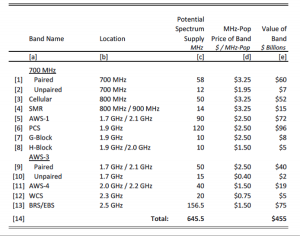No Way to Run a Railroad
![]() Spectrum is valuable, that much is certain. Exactly how valuable it is is a matter for economic analysis at a level that exceeds my knowledge of economics by an enormous degree. One recent analysis by Coleman Bazelon and Giulia McHenry of the Brattle Group estimates the “total economic value of the available licensed mobile broadband spectrum is $455 billion.”
Spectrum is valuable, that much is certain. Exactly how valuable it is is a matter for economic analysis at a level that exceeds my knowledge of economics by an enormous degree. One recent analysis by Coleman Bazelon and Giulia McHenry of the Brattle Group estimates the “total economic value of the available licensed mobile broadband spectrum is $455 billion.”
Technologists value spectrum in a different and much less sophisticated way: Our overarching goal is to create systems that lots of people will use; when Bill Gates and Steve Jobs were fighting it out in the 1980s to build the best desktop computers, they measured there success by the number of people who used their products.
Many activists value spectrum and other networking systems in terms of the amount of data they carry: by this analysis, unlicensed spectrum seems to be the cat’s pajamas because it carries most of the downloads that smartphone, tablet, and laptop users consume. But there’s a caveat to this measure, since most of the downloaded data in this measure is casual entertainment, which isn’t exactly a matter of life and death.
Positive Train Control – the system that prevents trains from colliding, going too fast, and going in the wrong direction – is a life and death issue, as we learned from the Amtrak derailment in Philadelphia recently. PTC only needs two megahertz to operate, so it doesn’t move a lot of data. But the data it does carry can be very, very important.
The finger pointing that followed the derailment hasn’t been pretty. The FCC published a blog post highlighting the role of the Federal Railroad Administration in overseeing the implementation of PTC and explaining the FCC had acted promptly in issuing licenses to railroads for the use of PTC spectrum. Another set of statements by unlicensed spectrum advocates at New America and Public Knowledge blamed the train wreck on Amtrak’s insistence on using licensed spectrum.
Both assert – without any evidence – that PTC can be implemented with Wi-Fi-like systems. While I suspect that parts of the system can be implemented with unlicensed in theory, the practical implications of several years of design and product development on the assumption that spectrum would be licensed can’t simply be brushed off.
PTC has technical issues: there are two standards for the system, and the only thing the railroads seem to be able to agree on is the use of licensed 220-222 MHz spectrum for train-to-train communication. Railroads have a number of competing systems for specific applications, such as collision avoidance, speed restriction, switching error avoidance, and worker protection. So these are costly, complex systems with a lot of technical detail and not nearly as much uniformity as many would like.
The debate over licensed vs. unlicensed spectrum in PTC ironically comes on the heels of the debate over the alleged “mooching” of Wi-Fi spectrum by LTE Unlicensed (see my comments on that issue). Without knowing the details of PTC, it seems apparent that the system doesn’t lend itself to a Wi-Fi-like solution.
The Amtrak train was speeding along the track at speeds of 100 MPH; if these trains were connecting to a series of Wi-Fi access points every 1000 feet, those access points would need to be very closely coordinated to manage the handoffs. So the likely scenario for redesigning PTC to run over unlicensed would be a “mooching” scenario where trains would use the same spectrum Wi-Fi uses but using it in a wholly different way.
One of the most important takeaways from the Amtrak derailment is the difficulty of developing new systems for old industries that use spectrum. This is a very technical subject that is well outside the expertise of railway engineers; it’s similar in that respect to auto safety systems that are targeted to use 5.9GHz spectrum allocated by Congress for their use. That spectrum directly conflicts with the planned expansion of Wi-Fi. These systems also stress the ability of radio engineers because they don’t know the application very well.
But the solutions do ultimately depend on blending the domain knowledge of the industries with the radio knowledge of engineers rather than policy wonks. It could very well be the case that the railroads would be best served by an LTE-U-like hybrid system that combines the licensed spectrum already in the hands of mobile operators with unlicensed spectrum capable of doing the up-close work of monitoring train speed, direction, and identity.
But we won’t know until the finger pointing stops and clear-headed adults get involved. In the meantime, let’s reflect that this is no way to run a railroad.
![]()
Can Positive Train Control be implemented using Wi-Fi spectrum, as some have argued? Or is it better suited to a combination of licensed and unlicensed spectrum? Sound off in the forum!




